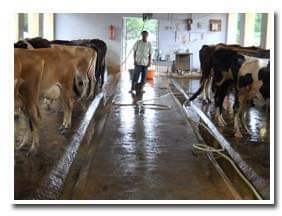Advantages of floor cleaning and disinfection of dairy sheds
Cleaning and disinfecting is imperative to maintain the well being and health of high producing animals, such as dairy cows. This is especially the case in intensive modern housing where high density and high productivity increases the infection pressure. Thorough cleaning and adapted disinfection decreases the pathogen level and prevents or breaks the disease cycle.
The ideal disinfectant:
Has a spectrum adapted to the target.
Is fast acting.
Has a sufficient efficiency within the contact time.
Remains active in the presence of organic matter.
Has a good material compatibility, for example with metals and concrete.
Has no or low toxicity for users.
Has an acceptable ecotoxicity.
Has an easy protocol of application.
Iodine, chlorine, glutaraldehyde, phenolic or quaternary ammonium compounds – none of these raw materials used in disinfectants respond to all these parameters. Thus, synergy is required: a mutually advantageous conjunction of distinct elements to get closer to the ‘myth’ of the ideal disinfectant. Complex formulations with several active substances that also contain stabilisers, sequestering agents and buffering agents offer the best compromise. Together with the chemical properties of the disinfectant, the method of application is a key factor to obtain good results.
Animal hygiene
The three main diseases with major economic Significance are mastitis, infertility and lameness. Two out of three have infectious components. Thus, using an adapted disinfectant is essential for the control of these diseases and consequently for farm profitability.
Teat hygiene.
There are three dangerous periods when cows are more vulnerable to mastitis causing agents:
During milking, if teat preparation is not optimal.
After milking, if the cow lies down in a dirty area with opened teat sphincters.
During the dry period.
During milking cows ‘share’ the milking machine and it is a source of contamination from one cow to another cow or one quarter to another quarter. Be aware: whatever bacteria are not removed from the teat sur- face before milking machine attachment will end up in the milk!
During the dry period
Hygiene of the cows, directly linked with environment hygiene, is of great importance in mastitis control and prevention. Again with the prevention of a build up of mastitis pathogens in mind, it is important to keep dry cow pens as clean as possible.
Hoof hygiene.
Considerable economic losses are attributable to lameness due to the cost of treatment, decreased milk production, decreased reproductive performance, and increased culling. The incidence of lameness has steadily increased over the last 20 years. Be proactive! Don’t wait to have a high prevalence in the herd before setting up a prevention strategy. The challenge regarding hooves disinfection is to find a disinfectant efficient in heavily contaminated solutions. The disinfectant should also reach the bacteria that are often deep in the tissues. Herd measures like footbaths, hoof mats and foaming systems are essential to control the spread ofthe disease. Pediline Pro has been formulated according to these specific needs. The claws have to be correctly trimmed at least once each year. Individual treatment, including antibiotic and healing processes may be useful.
Conclusion
Bacteria are everywhere: in soil, in water, on animals and on humans. The purpose of disinfection is to decrease infection pressure and thus decrease disease prevalence. Choosing the disinfectant adapted to each specific situation leads to effective prevention and a profitable dairy farm.


